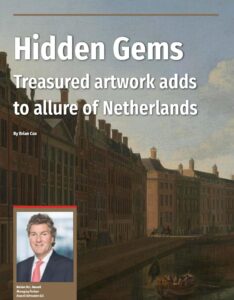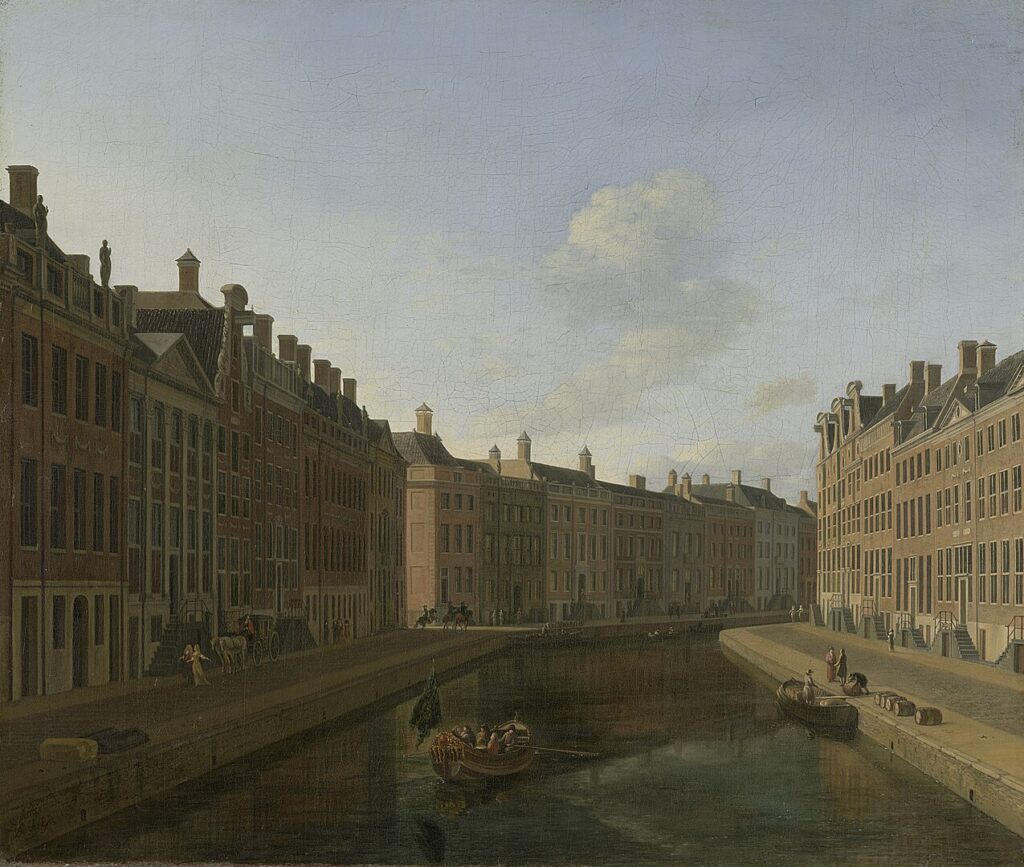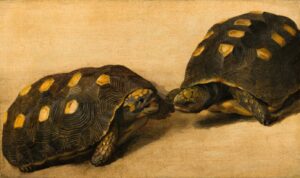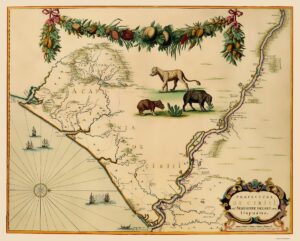Reinier adviseert nationale en internationale bedrijven
reinier.russell@russell.nl +31 20 301 55 55In his interview on “Hidden Gems – Treasured artwork adds to allure of Netherlands”, Reinier Russell talks about how artworks still reflect the spirit of the Golden Age and where they can be found.
 Download article or read the interview in the winter 2024 issue of The Primerus Paradigm.
Download article or read the interview in the winter 2024 issue of The Primerus Paradigm.
From the intrepidness of 17th century explorers to the pride of merchants in their prosperity, attorney Reinier Russell believes the spirit of the Dutch Golden Age is still evident in the Netherlands of today.
He even sees that spirit reflected in the values of his law firm, Russell Advocaten B.V. in Amsterdam.
“We have been solving problems for business owners for 80 years now,” he says of the firm his father, W.M.J. Russell, founded in 1943.
Reinier Russell and his older brother, Paul, along with Jan Dop are the current partners at the firm, which focuses on the corporate sector but also is internationally recognized as among the experts in the field of art and law. International art dealers, collectors, and museums from around the world seek the support of Russell Advocaten in disputes relating to authenticity of works of art, such as paintings, drawings, etchings, and sculptures of both old and modern art.
It is, in fact, through the artwork of 17th-century painters and printers that Reinier most dramatically finds representations of the spirt of the Dutch Golden Age that has endured over the centuries in the Netherlands.
The artwork to be discovered in the many museums of the Netherlands are what Reinier calls the country’s “hidden gems.”
 A painting by Gerrit Berckheyde titled the “View of the Golden Bend in the Herengracht” hangs in the Rijksmuseum in Amsterdam. The oil painting from 1671-1672 shows houses along the newly constructed Herengracht Canal, which became the section of the capital city where the wealthiest merchants and most influential members of Dutch society lived.
A painting by Gerrit Berckheyde titled the “View of the Golden Bend in the Herengracht” hangs in the Rijksmuseum in Amsterdam. The oil painting from 1671-1672 shows houses along the newly constructed Herengracht Canal, which became the section of the capital city where the wealthiest merchants and most influential members of Dutch society lived.
“The mere fact that a painting exists of these houses from this time is an indication of the pride the Dutch took in their prosperity,” says Russell. “Even today, the Herengracht is a prestigious address and when you are visiting Amsterdam, it is worthwhile to take a stroll and explore this area of the canal.”
Exploration and extensive trade were foundational to the Netherlands’ rise as a far-flung maritime empire in the 17th century, and Russell says the country remains a vibrant hub of global trade. As the managing partner of Russell Advocaten, he represents the interests of large Dutch companies and foreign companies based or active in the Netherlands.
The Dutch East India Co., formed in 1602, is actually the first company to offer equity shares of its business to the public, effectively conducting the world’s first initial public offering. The Amsterdam Stock Exchange is considered the oldest, still-functioning stock exchange in the world.
“Sailors went to the east and later to the west to see what was around the world and that is where we became the biggest investors all around the world,” says Russell. “Anywhere in the world you find Dutch investors.”
 In a 1640 painting by Albert Eckhout titled “Study of Two Brazilian Tortoises”, Russell sees an example of Dutch exploration expanding Europeans’ understanding of the broader world.
In a 1640 painting by Albert Eckhout titled “Study of Two Brazilian Tortoises”, Russell sees an example of Dutch exploration expanding Europeans’ understanding of the broader world.
Johan Maurits, governor of the Dutch colony in Brazil, took Eckhout and several other artists with him to South America to record the people, the flora and fauna, and the landscape. Eckhout painted the two tortoises in great detail. The painting now hangs in the Mauritshuis, which is located in The Hague and is a small world-class museum with an impressive collection of Dutch and Flemish paintings from the 17th century.
Centuries later, the Netherlands and Brazil remain strongly connected through trade. Russell is the honorary counsel for Brazil, a role he took over from his father who served in the post for 25 years.
Exploration also produced a boon in Dutch cartography during the 17th century.
 Brothers Johannes and Cornelis Blaeu were Dutch cartographers with a studio in Amsterdam where they created superbly detailed maps, including the famous “Atlas Maior.” Russell highlights the brothers’ “Historic Map of Sergipe, Brazil,” drawn in 1662, on which they depict native animals they had never seen themselves. The Blaeus drew the animals from descriptions provided by returning sailors.
Brothers Johannes and Cornelis Blaeu were Dutch cartographers with a studio in Amsterdam where they created superbly detailed maps, including the famous “Atlas Maior.” Russell highlights the brothers’ “Historic Map of Sergipe, Brazil,” drawn in 1662, on which they depict native animals they had never seen themselves. The Blaeus drew the animals from descriptions provided by returning sailors.
Another example of the brothers’ astounding talents is a 1655 map of Beijing, China, on which the cartographers painted people dressed in traditional Chinese attire.
“The Blaeu brothers created these maps for wealthy Amsterdam merchants who were more than happy to display their prosperity and knowledge of the world to visitors,” explains Russell. “It shows the knowledge the Dutch had about foreign cultures at the time.”
Russell compares the Blaeu brothers’ ability to use knowledge and the use of their wide contacts with sailors and other travelers to produce accurate maps of regions of the earth where they had never gone to the practice of law.
“You have to know people and you have to have the knowledge,” he says. “Knowledge alone is not enough. Knowing people is not enough if you don’t have the knowledge. So, you have to combine both.”
Artwork celebrating Dutch history and bearing testimony to the Dutch desire to discover and understand the world can be found in museums and universities across Amsterdam. The Rijksmuseum “is a treasure,” according to Russell.
“You can spend one, two, three days there and still not see everything,” he says.
Other museums include the Van Gogh Museum, which houses more than 1,400 pieces of Vincent van Gogh’s work, and the Stedelijk Museum, which features more than 90,000 pieces of modern art.
Today, the Netherlands exhibits its contemporary international presence through the air and on the sea. Schiphol Airport is one of the best-connected airports in the world, serving 350 destinations across the globe, and the Port of Rotterdam remains the largest seaport in Europe and among the biggest in the world.
“We’re well connected,” says Russell. “The environment here is safe, straight-forward, and good for doing business.”
Russell says his firm’s membership in Primerus since 2010 is another example of his firm’s commitment to international business.
“The merchant spirit from the Dutch Golden Age is still alive in the Netherlands,” says Russell, who has sat on the Primerus Board of Directors and has chaired the International Outside Corporate Counsel Practice Group. “We even have a special website for companies that want to become active in the Netherlands.” (The site is startingabusinessnl.com.)
Even as art plays an important role in illustrating the Netherlands’ history — especially the lasting influence of the Dutch Golden Age — artwork also is key to creating the culture of the offices of Russell Advocaten where framed art decorates most walls.
“It makes life a little bit nicer,” says Russell.
De regering heeft in een brief aangegeven hoe zij de voorstellen uit de adviezen van de Commissie-Buma in regelgeving wil gaan omzetten. Wat betekent dit in de praktijk voor particulieren die kunst of andere cultuurgoederen in eigendom hebben? Maar eerst: wat zijn de regels voor de uitvoer van beschermde cultuurgoederen op dit moment?
De regering heeft in een brief aangegeven hoe zij de voorstellen uit de adviezen van de Commissie-Buma in regelgeving wil gaan omzetten. Wat betekent dit in de praktijk voor particulieren die kunst of andere cultuurgoederen in eigendom hebben? Lost dit de problemen van eigenaren op?
Een belangrijk onderdeel van de corporate governance is het naleven van de verschillende regels die voor de onderneming gelden: compliance. Hoe zorgt u dat uw bedrijf compliant wordt en blijft?
De aandeelhoudersovereenkomst is de belangrijkste overeenkomst die tussen aandeelhouders en de vennootschap wordt gesloten. Welke zaken dient u in deze overeenkomst te regelen?
Het kan grote gevolgen hebben wanneer een orgaan binnen de vennootschap een besluit neemt waartoe het niet bevoegd is. Wat zijn deze gevolgen en hoe voorkomt u dat een besluit op de verkeerde wijze wordt genomen?
In deze blog geven wij een kort overzicht van de belangrijkste organen die in een onderneming aanwezig zijn en wat hun bevoegdheden zijn.